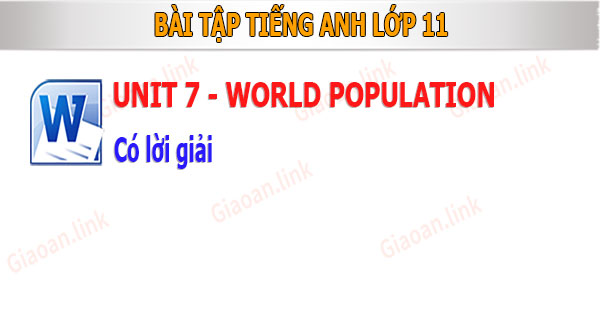Bài tập tiếng anh 11 Unit 7 World Population có đáp án. Mời các bạn tham khảo, xem online và tải file word bên dưới.
| XEM BÀI TẬP ONLINE |
|---|
UNIT 7: READING & VOCABULARY
(Bài tập tự luyện)
Exercise 1: PRONUNCIATION
Choose the word that has the underlined part pronounced differently from the others.
1. a. limit b. figure c. iron d. billion
2. a. great b. available c. raise d. said
3. a. decreased b. used c. reached d. developed
4. a. program b. earth c. birth d. produce
5. a. double b. govern c. punish d. control
Exercise 2: Fill in the blank with a suitable word to complete the passage.
China is the most populous country of the world. Its (1) _ is approximately 1.3 billion people, which is almost 22% of the (2) population. The population density is high in the southeast: 43 percent of the land contains most
of its population. A quarter of the population (3)
China is in the middle and
lower parts of the Yangtze River, and the population density (4) _ 663 people per square kilometer. Shanghai is China’s largest city, (5) _ population density reaches 2,118 people per square kilometer.
China’s population growth rate has (6) _ in the past years, although its population is still increasing. In the 1970s, the government started to implement birth
(7) programs to the people: late marriage, late childbearing, a one-child family, and a four-year period between two (8) in the countryside where each couple may have more than one child, According to the report of Major Figures of Population of China, the annual growth rate of China’s population (9) from 25.83% (in 1070) down to 11.21% (in 1994) and to 8.77% (in 1999) in the past 20 years. This should be (10) _ a great success.
Exercise 3: Fill in each blank space with one appropriate word from the box.
mortality expanding growth increasing reach decline
population even slightly life variations available
WORLD POPULATION
Projections issued in 2000 showed the world population (31) from 6.1 billion in 2000, to 7.9 billion in 2050. “High” and “low” projections for 2025 are 8.4 billion and 7.5 billion respectively. The average world birth rate is projected to (32)
from the 1990 level of 26 per 1,000 to 22 per
1,000 at the .end of the century and to 17.6 per 1,000 in 2025 (corresponding to a fall in TFH from 3.3 in 1990 to 2.1 in 2025). Because of the (33) share of the population at high-mortality ages, the average world death Tate is expected to decline only (34) _ ; from 9 (per 1,000) in 1990 to 8.4 in 2025. Average world (35)
expectancy, however, is projected to rise from 65 years in 1990 to 71.3 years in 2025. Wide (36) in population growth will undoubtedly persist. In the developed world, population growth will continue to be very low and in some nations will (37) decline. Western Europe as a whole is projected to have a declining population after 2000. U.S. Census Bureau projections, assuming middle fertility and
(38) levels, show U.S. (39) increasing from 250 million in’ 1990 to
349 million in 2025 and 420 million in 2050. Thereafter, (40) _ virtually zero.
would be
Exercise 4: Choose the word or phrase – a, b, c or d – that best fits the blank space in the following passage.
Mexico City is growing quickly. In 1970, the city had about 9 million people.
Now it has over 17 million. All these people are causing (1)
for the city. There
are not (2) jobs. Also, there is’ not enough housing. Large families have to live together in small homes. Many homes do not have water. They also do not have bathrooms or electricity. The Mexican government is (3) _ about all these
problems. It is working hard to make (4)
better in the city.
Why is Mexico City growing so (5) ? Where are all these people coming from? They are coming to the city from the country. Life is hard on the farms in Mexico. Most people on farms have to live a very simple life. They have no (6)
money for modern things. People think life in the city must be (7) . So they leave their farms and move to Mexico City.
(8)
All around the world, large cities have the same problems. One of them is air
. Mexico City has pad air. It is dirty and (9) . Cars are one reason
for the dirty air. Many Mexicans now own their own cars and drive in the city. The factories in the area also cause air pollution. These factories put a lot of (10) into the air. It is not easy to clean up the air in a large city. The government has to make new laws, and everyone has to help.
1. a. problems
2. a. much b. matters
b. lack c. things
c. enough d. news
d. many
3. a. worried
4. a. duration
b. interested
b. circle
c. discussed
c. live
d. known
d. life
5. a. normal
6. a. bonus b. fast
b. extra c. slow
c. added d. average
d. given

